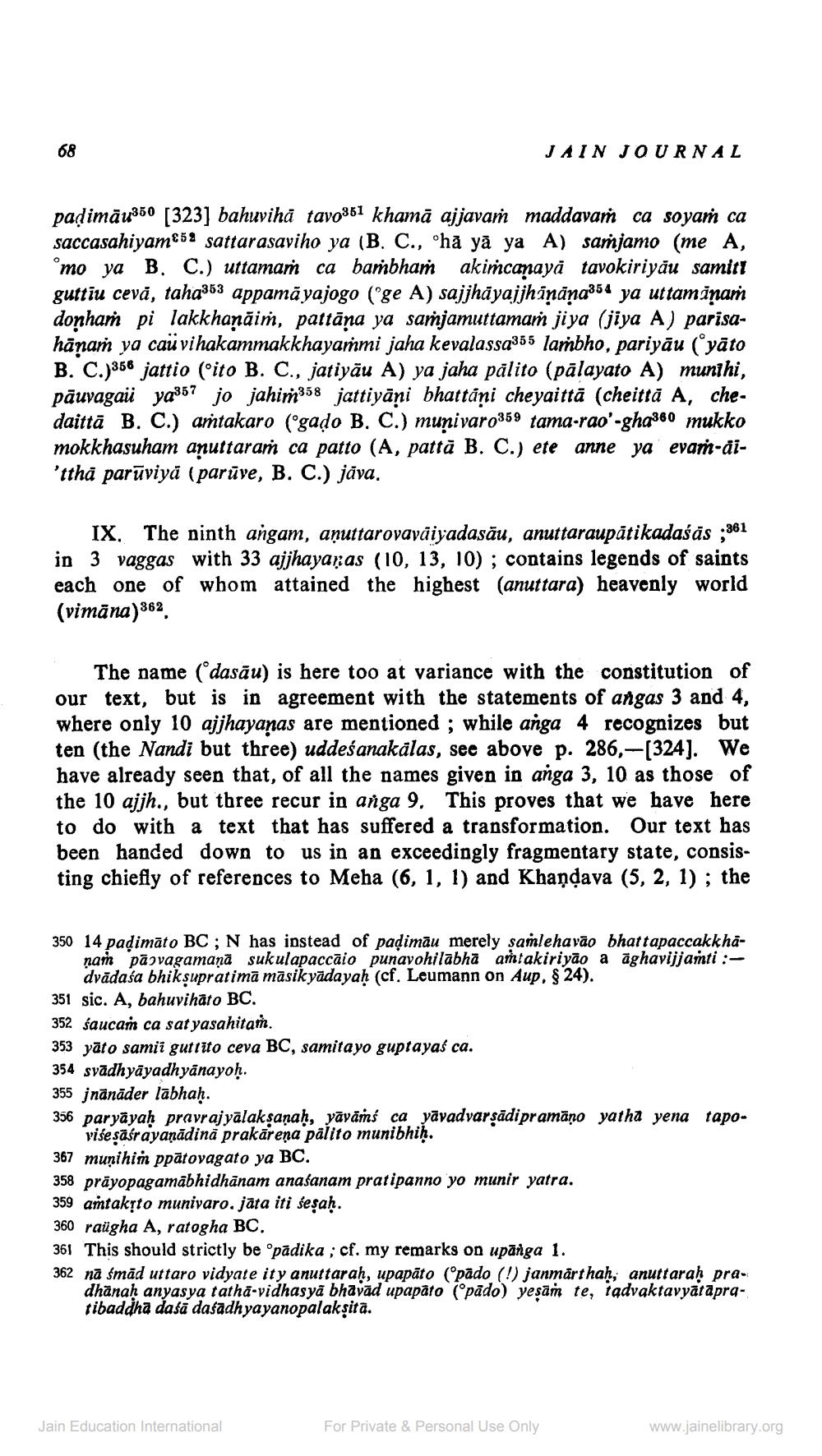________________
JAIN JOURNAL
padimā4350 [323] bahuviha tavo361 khamā ajjavam maddavaṁ ca soyam ca saccasahiyam€52 sattarasaviho ya (B. C., °ha yā ya A) saṁjamo (me A, omo ya B. C.) uttamaṁ ca bambhař akimcanaya tavokiriyňu samitt guttiu ceva, taha363 appamāyajogo (@ge A) sajjhāyajjhimāna354 ya uttamīnam donhaṁ pi lakkhanāiń, pattāna ya sarjamuttamaṁ jiya (jiya A) parisahānaṁ ya caü vihakammakkhayaṁmi jaha kevalassa355 lambho, pariyāu oyāto B. C.)366 jattio oito B. C., jatiyāu A) ya jaha palito (pālayato A) munihi, pāuvagaii ya357 jo jahim358 jattiyāni bhattáni cheyaittā (cheittà A, chedaittà B. C.) aṁtakaro (gado B. C.) munivaro359 tama-rao'-gha360 mukko mokkhasuham anuttaraṁ ca patto (A, pattă B. C.) ete anne ya evar-di'tthā parūviya (parūve, B. C.) jāva.
IX. The ninth angam, aņuttarovaväiyadasāu, anuttaraupātikadaśās ;381 in 3 vaggas with 33 ajjhayaņas (10, 13, 10); contains legends of saints each one of whom attained the highest (anuttara) heavenly world (vimāna)362
The name (dasāu) is here too at variance with the constitution of our text, but is in agreement with the statements of angas 3 and 4, where only 10 ajjhayanas are mentioned ; while anga 4 recognizes but ten (the Nandi but three) uddeśanakalas, see above p. 286,-(324). We have already seen that, of all the names given in anga 3, 10 as those of the 10 ajjh., but three recur in anga 9. This proves that we have here to do with a text that has suffered a transformation. Our text has been handed down to us in an exceedingly fragmentary state, consisting chiefly of references to Meha (6, 1, 1) and Khandava (5, 2, 1); the
350 14 padimāto BC; N has instead of padimāu merely samlehavão bhattapaccakkhā
nam pāovagamana sukulapaccāio punavohilabha aṁtakiriyāo a āghavijjanti :
dvādaśa bhik supratimā māsik yadayah (cf. Leumann on Aup. $ 24). 351 sic. A, bahuvihato BC. 352 saucam ca sat yasahitam. 353 yāto samii guttito ceva BC, samitayo guptayas ca. 354 svādhyāyadhyānayoḥ. 355 ;nānāder labhah. 356 paryāyah pravrajyalaksanah, yāyāmś ca yāvadvarsādi pramāno yatha yena tapo
vise şaśrayanādină prakārena pålito munibhiḥ. 367 munihim ppātovagato ya BC. 358 präyopagamábhidhānam anaśanam pratipanno yo munir yatra. 359 amtakyto munivaro. jäta iti sesah. 360 raügha A, ratogha BC. 361 This should strictly be opädika ; cf. my remarks on upanga 1. 362 na śmåd uttaro vidyate ity anuttaraḥ, upapāto (pado (!) janmärthah, anuttaraḥ pra.
dhānah anyasya tathā-vidhasya bhāvād upapăto (pådo) yesām te, tadvaktavyātāpraribaddha dasā daśadhyayanopalaksita.
Jain Education International
For Private & Personal Use Only
www.jainelibrary.org




